The modern marathon is 26 miles, 385 yards (42.195K), and it seems that there should be some rationale behind the distance. I mean, we’ve even created a race of half the distance called the “half-marathon.” Surely, there must be some good reason why the race isn’t just 20 miles, or maybe even 25. Right?
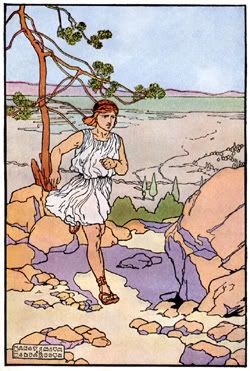
According to legend, the marathon commemorates the run in 490 B.C. of a Greek soldier named Pheidippides. So how far did Pheidippides run? The Greek historian Herodotus wrote that the Athenians sent a military courier named Pheidippides to request help from Sparta. He covered that distance (about 150 miles) in less than two days. This sounds a little long for a race but, with the advent of the “ultra-marathon,” perhaps there is an audience for Herodotus’ version of the “marathon.”
Luckily, legend makers came to the rescue. About 600 years after Herodotus wrote about Pheidippides, the legend arose that Pheidippides had been sent to Athens to bring news of the victory of the Greeks over the Persians at Marathon. After reaching Athens, he delivered the joyous message, “Niki!” (“victory”), and then died from exhaustion. The distance between Marathon and Athens is about 25 miles, and a phenomenon was born.
Or was it? The Greeks came up with reviving the Marathon for the first modern Olympics in 1896, and the first marathon was actually a time trial for the 1896 Olympics. This first marathon was won by Charilaous Vasilakos in 3 hours and 18 minutes. The course went from Marathon Bridge to the Olympic Stadium in Athens, a distance of 40 kilometers, or 24.85 miles. The marathon in the 1896 Olympics was won by Spiridon Louis, a Greek postal worker, with a time of 2 hours, 58 minutes, 50 seconds, an average pace of 7:11 minutes per mile. Spiridon is definitely my kind of guy: he won the Olympics despite stopping on the way for a glass of wine!
The first marathon in the United States was on April 9, 1897 in Boston. There were 15 runners, and John McDermott won the 24.5 mile race in 2 hours, 55 minutes, and 10 seconds. The 26.2 mile distance was not established until the 1908 Olympics in London. The course covered the ground from Windsor Castle to White City Stadium, and the royals added 385 yards so the race could finish in front of the royal family's viewing box. We can all thank the British for the 26.2 mile distance!
For most of the first half of the 20th century, the Boston Marathon and the Olympic Marathon were the only regularly scheduled marathons. It was not until the 1960s and 1970s, during the jogging craze, the recreational runners thought it might be a good idea to run the distance.

Despite the longer distance, winning times are also a lot faster now. Paul Tergat from Kenya is the fastest man to run a marathon, setting the record on September 28, 2003 at the Berlin Marathon with a time of 2 hours, 4 minutes, and 55 seconds (
4:45/mile). The current world record holder for the women’s marathon is Paula Radcliffe, a distance runner from England.

She set the record on April 13, 2003 at the London Marathon with a time of 2 hours, 15 minutes, and 25 seconds (5:10/mile).
The Las Vegas Marathon
The Las Vegas Marathon is one of the oldest marathons in the United States, having been run since 1967. By comparison, the biggest marathon in the United States, the New York City Marathon, started in 1970.

The Las Vegas Marathon has gone through some drastic changes, however, and the course underwent a major facelift last year. The old course started in Jean, Nevada, around 15 miles north of the California-Nevada State line. In Jean, you can find the Gold Strike and Nevada Landing casinos, and it is only about 10 miles from Primm on the State line, home to Whiskey Pete’s, the Primadonna, and Buffalo Bill’s. If you’ve driven to Las Vegas from Southern California, I’m sure you’ve seen the sign, but the thought of stopping there never crossed your mind, particularly in the frenzy of the final half hour of the drive to Las Vegas itself. On race day, runners presumably had to be bused out to this desert location and left to find their way back to Las Vegas.
The original course was desolate, and spectators could not even cheer on runners until mile 15. The original course also went nowhere the Strip, ending up someplace in Las Vegas called “Sunset Park.” Not surprisingly, the original course triggered comments like the following (I’m not making this up):
• "It was horrible, ugly, nasty, scary, just plain awful. I can't think of any other words to describe the experience. Don't do this one!!!"
• "I recently received my finisher's certificate from the marathon and it reawakened miserable thoughts about this year's race . . . SUPPORT???!! Was there any? Running out of cups at one of the water stops, no gels, no oranges -- just a lot of wind both from Mother Nature and from the organizers. I can't figure out what happened to the $75 entry fee if all we got was a ride in a school bus to the start... "
• "Coming to Las Vegas on vacation? Do the marathon. Maybe. Coming to Las Vegas for the marathon? Forget it. Save your money and play the slots. Your odds at getting more out of them will be better than what you get out of the money spent on the entry fee. I can usually find something good to say about all the marathons I have done (this was #72), but can't think of much good about this one. Oh yes, as one of the previous commentators said, they let us stay on the bus up until the start. Wait, I remember something else that was good... we only had to deal with 30-35 mph headwinds; no rain, sleet; dust or freezing temperatures."
• "Seriously, the wind and dust started around mile 15 and lasted through mile 25. I ended the race feeling like a Sand Trooper from Star Wars. Don't expect a glorious start/finish with thousands of spectators in front of the Mirage Volcano or the Bellagio water show. In fact, spectators consist of passing tumbleweeds and the occasional blue-belly lizard."
Last year, the race was renamed "The New Las Vegas Marathon", and the course was updated to include both the Strip and Fremont Street. The new course marks one of the rare occasions that the Strip is closed to traffic. I also understand that the race is now very well supported, so no need to bring cups. The men’s record for the New Las Vegas Marathon was set by Stephen Kiogora (2:11:56), and the women’s record by Adriana Fernandez (2:31:54). With the course running down the Strip, I hope to make like Spiridon Louis and perhaps enjoy a fine glass of wine on my way to victory!
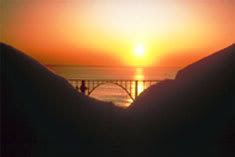 The trail starts just across the street from
The trail starts just across the street from 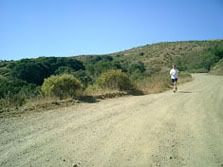 This was by far the toughest run I have ever been on: I was forced to walk large (uphill) portions of it, and was actually praying that Jess (who was running a much shorter distance) would start wondering where I was and save me with the car. The first 2 1/2 miles were entirely uphill, rising nearly 1,000 feet. This was followed by an abrupt, steep drop of 900 feet over the next two miles, coupled with the knowledge that I would have to return up this steep climb. This descent was followed by another climb of 500 feet over the next 3/4 of a mile (my GPS could not pick up a signal through much of the thick foliage while I was at the bottom of the valley near the Big Sur River, so I actually ran longer than 10 miles). In short, it was miserable, and took me nearly two hours to cover 10.5 miles. Yeah, the scenery was beautiful (expansive views of the ocean, and I even saw a couple of deer on the way back), but I was thinking more about survival than my surroundings. Here I am, in my official Las Vegas Marathon training gear, glad to be alive:
This was by far the toughest run I have ever been on: I was forced to walk large (uphill) portions of it, and was actually praying that Jess (who was running a much shorter distance) would start wondering where I was and save me with the car. The first 2 1/2 miles were entirely uphill, rising nearly 1,000 feet. This was followed by an abrupt, steep drop of 900 feet over the next two miles, coupled with the knowledge that I would have to return up this steep climb. This descent was followed by another climb of 500 feet over the next 3/4 of a mile (my GPS could not pick up a signal through much of the thick foliage while I was at the bottom of the valley near the Big Sur River, so I actually ran longer than 10 miles). In short, it was miserable, and took me nearly two hours to cover 10.5 miles. Yeah, the scenery was beautiful (expansive views of the ocean, and I even saw a couple of deer on the way back), but I was thinking more about survival than my surroundings. Here I am, in my official Las Vegas Marathon training gear, glad to be alive: 

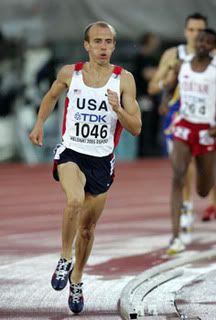 I also mentioned this long run to one of my co-workers, Christina, who has not run long distances regularly, but is faster than both of us. She clearly outpaced us during the
I also mentioned this long run to one of my co-workers, Christina, who has not run long distances regularly, but is faster than both of us. She clearly outpaced us during the 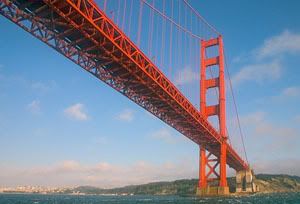 The variety of scenery is amazing, and we got to see a nice cross-section of San Francisco. The weather was also nice and cool although the winds really started to whip up as we approached the bridge.
The variety of scenery is amazing, and we got to see a nice cross-section of San Francisco. The weather was also nice and cool although the winds really started to whip up as we approached the bridge.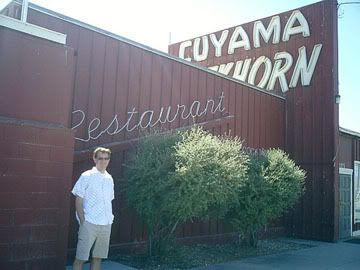
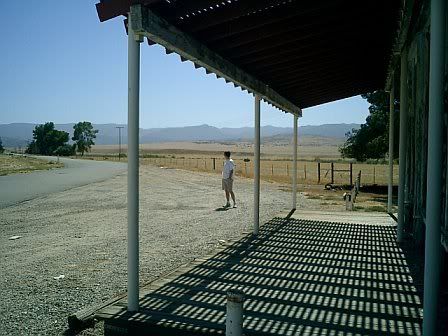

 Despite the longer distance, winning times are also a lot faster now. Paul Tergat from Kenya is the fastest man to run a marathon, setting the record on September 28, 2003 at the Berlin Marathon with a time of 2 hours, 4 minutes, and 55 seconds (4:45/mile). The current world record holder for the women’s marathon is Paula Radcliffe, a distance runner from England.
Despite the longer distance, winning times are also a lot faster now. Paul Tergat from Kenya is the fastest man to run a marathon, setting the record on September 28, 2003 at the Berlin Marathon with a time of 2 hours, 4 minutes, and 55 seconds (4:45/mile). The current world record holder for the women’s marathon is Paula Radcliffe, a distance runner from England.  She set the record on April 13, 2003 at the London Marathon with a time of 2 hours, 15 minutes, and 25 seconds (5:10/mile).
She set the record on April 13, 2003 at the London Marathon with a time of 2 hours, 15 minutes, and 25 seconds (5:10/mile). The Las Vegas Marathon has gone through some drastic changes, however, and the course underwent a major facelift last year. The old course started in Jean, Nevada, around 15 miles north of the California-Nevada State line. In Jean, you can find the Gold Strike and Nevada Landing casinos, and it is only about 10 miles from Primm on the State line, home to Whiskey Pete’s, the Primadonna, and Buffalo Bill’s. If you’ve driven to Las Vegas from Southern California, I’m sure you’ve seen the sign, but the thought of stopping there never crossed your mind, particularly in the frenzy of the final half hour of the drive to Las Vegas itself. On race day, runners presumably had to be bused out to this desert location and left to find their way back to Las Vegas.
The Las Vegas Marathon has gone through some drastic changes, however, and the course underwent a major facelift last year. The old course started in Jean, Nevada, around 15 miles north of the California-Nevada State line. In Jean, you can find the Gold Strike and Nevada Landing casinos, and it is only about 10 miles from Primm on the State line, home to Whiskey Pete’s, the Primadonna, and Buffalo Bill’s. If you’ve driven to Las Vegas from Southern California, I’m sure you’ve seen the sign, but the thought of stopping there never crossed your mind, particularly in the frenzy of the final half hour of the drive to Las Vegas itself. On race day, runners presumably had to be bused out to this desert location and left to find their way back to Las Vegas.
